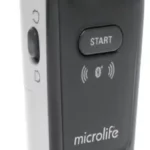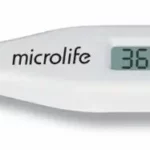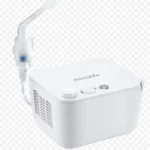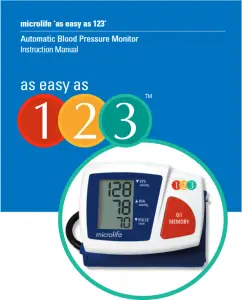
IB BP 3BXO-A 3804_4 16/9/04 13:24 Page 1
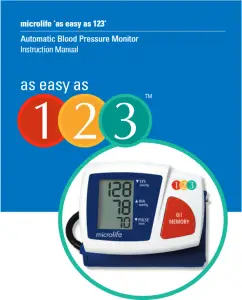
CE0044

IB BP 3BXO-A 3804_4 16/9/04 13:24 Page 3
Automatic Blood Pressure Monitor
Instruction Manual
Table of contents
1. Introduction
1.1. Features of ‘as easy as 123’
1.2. Important information about self-measurement
2. Important information on the subject of blood-pressure and its measurement
2.1. How does high/low blood-pressure arise?
2.2. Which values are normal?
2.3. What can be done, if regular high/low values are obtained?
3. The various components of the blood-pressure monitor
4. Putting the blood-pressure monitor into operation
4.1. Inserting the batteries
4.2. Using a mains adapter (optional accessory)
4.3. Tube connection
5. Carrying out a measurement
5.1. Before the measurement
5.2. Common sources of error
5.3. Fitting the cuff
5.4. Measuring procedure
5.5. Memory – displaying the last measurement
5.6. Discontinuing a measurement
6. Error messages/malfunctions
7. Care and maintenance, recalibration
8. Guarantee
9. Reference to standards
10. Technical specifications
11. Contact details
IB BP 3BXO-A 3804_4 16/9/04 13:24 Page 2
1. Introduction
1.1. Features
The ‘as easy as 123’ blood-pressure monitor is a fully automatic, digital blood-pressure measuring device for use on the upper arm, which enables very fast and reliable measurement of the systolic and diastolic blood-pressure as well as the pulse frequency by way of the oscillometric method of measuring.The device offers a very high and clinical tested measurement accuracy and has been specifically designed for ease of use.
Thanks to the large LCD display of ‘as easy as 123’, both operational status and cuff pressure are visible for the entire duration of the measurement.
Before using, please read through this instruction manual carefully and then keep it in a safe place. For further questions on the subject of blood-pressure and its measurement, please contact your doctor.
Attention!
1.2. Important information about self-measurement
- Do not forget: self-measurement means Control, not diagnosis or treatment. Unusual values must always be discussed with your doctor. Under no circumstances should you alter the dosages of any drugs prescribed by your doctor.
- The pulse display is not suitable for checking the frequency of heart pacemakers!
- In cases of cardiac irregularity (Arrhythmia), measurements made with this instrument should only be evaluated after consultation with the doctor.
Electromagnetic interference
The device contains sensitive electronic components (Microcomputer). Therefore, avoid strong electrical or electromagnetic fields in the direct vicinity of the device (e.g. mobile telephones, microwave cookers). These can lead to temporary impairment of the measuring accuracy.
2. Important information on the subject of blood-pressure and its Measurement
2.1. How does high/low blood-pressure arise?
The level of blood-pressure is determined in a part of the brain, the so-called circulatory centre, and adapted to the respective situation by way of feedback via the nervous system.
To adjust the blood-pressure, the strength and frequency of the heart (Pulse), as well as the width of circulatory blood vessels is altered. The latter is effected by way of fine muscles in the blood-vessel walls.The level of arterial blood-pressure changes periodically during the heart activity: During the «blood ejection» (Systole) the value is maximal (systolic blood-pressure value), at the end of the heart’s «rest period» (Diastole) minimal (diastolic blood-pressure value).
The blood-pressure values must lie within certain normal ranges in order to prevent particular diseases.
2.2. Which values are normal?
Blood pressure is too high if at rest, the diastolic pressure is above 90 mm Hg and/or the systolic blood-pressure is over 140 mm Hg. In this case, please consult your doctor immediately. Long-term values at this level endanger your health due to the associated advancing damage to the blood vessels in your body.
With blood-pressure values that are too low, i.e. systolic values under 100 mm Hg and/or diastolic values under 60 mm Hg, likewise, please consult your doctor.
Even with normal blood-pressure values, a regular self-check with your blood-pressure monitor is recommended. In this way you can detect possible changes in your values early and react appropriately.
If you are undergoing medical treatment to control your blood pressure, please keep a record of the level of your blood pressure by carrying out regular self-measurements at specific times of the day. Show these values to your doctor. Never use the results of your measurements to alter independently the drug doses prescribed by your doctor.
Table for classifying blood-pressure values (units mm Hg) according to World Health Organization:

2.3. What can be done, if regular increased/low values are obtained?
a) Please consult your doctor.
b) Increased blood-pressure values (various forms of hypertension) are associated long- and medium term with considerable risks to health. This concerns the arterial blood vessels of your body, which are endangered due to constriction caused by deposits in the vessel walls (Arteriosclerosis). A deficient supply of blood to important organs (heart, brain, muscles) can be the result. Furthermore, with long-term continuously increased blood-pressure values, the heart will become structurally damaged.
3
IB BP 3BXO-A 3804_4 16/9/04 13:24 Page 4
c) There are many different causes of the appearance of high blood pressure. We differentiate between the common primary (essential) hypertension, and secondary hypertension. The latter group can be ascribed to specific organic malfunctions. Please consult your doctor for information about the possible origins of your own increased blood pressure values.
d) There are measures which you can take, not only for reducing a medically established high blood pressure, but also for prevention. These measures are part of your general way of life:
A) Eating habits
- Strive for a normal weight corresponding to your age. Reduce overweight!
- Avoid excessive consumption of common salt.
- Avoid fatty foods.
B) Previous illnesses
- Follow consistently any medical instructions for treating previous illness such as:
- Diabetes (Diabetes mellitus)
- Fat metabolism disorder
- Gout
C) Habits
- Give up smoking completely
- Drink only moderate amounts of alcohol
- Restrict your caffeine consumption (Coffee)
D) Physical constitution
- After a preliminary medical examination, do regular sport.
- Choose sports which require stamina and avoid those which require strength.
- Avoid reaching the limit of your performance.
- With previous illnesses and/or an age of over 40 years, please consult your doctor before beginning your sporting activities. He will advise you regarding the type and extent of types of sport that are possible for you.
3. The various components of the ‘as easy as 123’
The illustration shows the blood-pressure monitor ‘as eas as 123’ consisting of:
a) Measuring unit
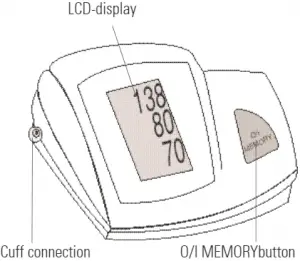
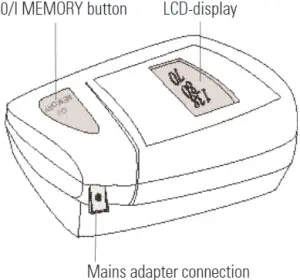
b) Upper arm cuff:
Type M for arm circumference 22–32 cm
Type L for arm circumference 32–42 cm
(Type L – available as special accessory)
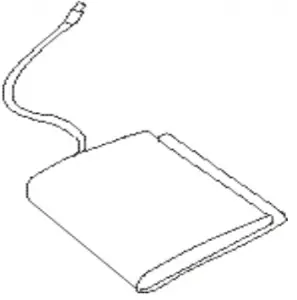
5
IB BP 3BXO-A 3804_4 16/9/04 13:24 Page 6
4. Putting the blood-pressure monitor into operation
4.1. Inserting the batteries
After you have unpacked your device, first insert the batteries. The battery compartment is located on the back side of the device (see illustration).
a) Remove cover as illustrated

b) Insert the batteries (4 x size AA 1,5 V), there by observing the indicated polarity.
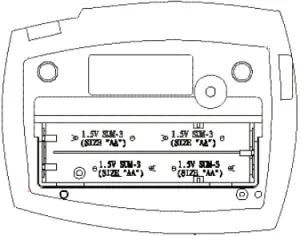
c) If the battery warning appears in the display, the batteries are empty and must be replaced by new ones:
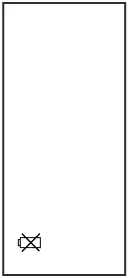
Attention!
- After the battery warning appears, the device is blocked until the batteries have been replaced.
- Please use «AA» Long-Life or Alkaline 1.5V Batteries.The use of 1.2V Accumulators is not recommended.
- If the blood-pressure monitor is left unused for long periods, please remove the batteries from the device.
4.2. Using a mains adapter (optional accessory)
It is possible to operate this blood-pressure instrument through a mains adaptor (output 6 V DC / 600 mA with plug). Make certain that you use a mains adaptor which fulfils the legal requirements (CE sign ).
a) Plug the plug into the socket at the left side of the instrument.
b) Plug the mains adaptor into a 230V power socket.
c) Test that power is available by pressing the O/I MEMORY button.
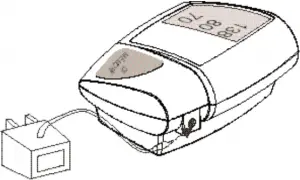
Note:
- No power is taken from the batteries while the mains adaptor is connected to the instrument.
- If the mains voltage is interrupted during the measurement (e.g. by removal of the mains adaptor from the mains socket), the instrument must be reset by removing the plug from its socket.
- Please consult a specialist dealer if you have questions relating to the mains adaptor.
6
4.3. Tube connection
Insert the cuff tube into the opening provided on theleft side of the instrument, as shown in the diagram.
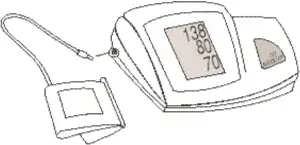
5. Carrying out a measurement
5.1. Before the measurement:
- Avoid eating, smoking as well as all forms of exertion directly before the measurement. All these factors influence the measurement result. Try and find time to relax by sitting in an armchair in a quiteatmosphere for about 5 minutes before the measurement.
- Remove any garment that fits closely to your upper arm.
- Measure always on the same arm (normally left).
- Attempt to carry out the measurements regularly at the same time of day, since the blood-pressure changes during the course of the day.
5.2. Common sources of error
Note: Comparable blood-pressure measurements always require the same conditions! These are normally always quiet conditions.
- All efforts by the patient to support the arm can increase the blood-pressure. Make sure you are in a comfortable, relaxed position and do not activate any of the muscles in the measurement arm during the measurement. Use a cushion for support if necessary.
- If the arm artery lies considerably lower (higher) than the heart, an erroneously higher (lower) blood-pressure will be measured! (Each 15 cm difference in height results in a measurement error of 10mm Hg!)
- Cuffs that are too narrow or too short result in false measurement values. Selecting the correct cuff is of extraordinary importance. The cuff size is dependent upon the circumference of the arm (measured in the centre). The permissible range is printed on the cuff. If this is not suitable for your use, please contact your dealer.
Note: Only use clinically approved Original-Cuffs! - A loose cuff or a sideways protruding air-pocket causes false measurement values.
5.3. Fitting the cuff
a) Push the cuff over the left upper arm so that the tube point sin the direction of the lower arm.
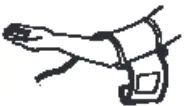
b) Lay the cuff on the arm as illustrated. Make certain that the lower edge of the cuff lies approximately 2 to 3 cm above the elbow and that the rubber tube leaves the cuff on the inner side of the arm.
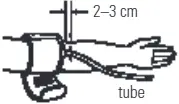
Important! The mark (ca. 3 cm long bar) must lie over the artery which runs down the inner side of the arm.
7
IB BP 3BXO-A 3804_4 16/9/04 13:24 Page 8
c) Tighten the free end of the cuff and close the cuff with the closer.

d) There must be no free space between the arm and the cuff as this would influence the result. Clothing must not restrict the arm.

e) Secure the cuff with the Velcro closer in such a way that it lies comfortably and is not too tight. Lay the arm on the table (palm upwards) so that the cuff is at the same height as the heart. Make sure that the tube is not kinked.

f) Remain seated quietly for 2 minutes before you begin the measurement.
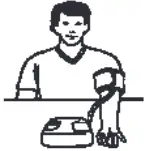
Note:
If it is not possible to fit the cuff to the left arm, it can also be placed on the right one. However all measurements should be made using the same arm
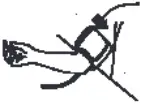
5.4. Measuring procedure
After the cuff has been appropriately positioned the measurement can begin:
a) Press the O/I MEMORY button, – the pump begins to inflate the cuff. In the display, the increasing cuff-pressure is continually displayed.
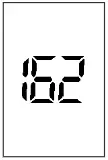
b) After reaching the inflation pressure, the pump stops and the pressure slowly falls away. The cuff-pressure (large characters) is displayed during the measurement.
c) When the device has detected the pulse, the heart symbol in the display begins to blink and a peep tone is audible for every pulse beat.
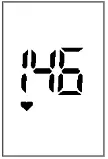
8
d) When the measurement has been concluded, a long peep tone sounds. The measured systolic and diastolic blood-pressure values as well as the pulse frequency are now displayed.
e) The measurement results are displayed, until you switch the device off. If no button is pressed for 5 minutes, the device switches automatically off, to save the batteries.
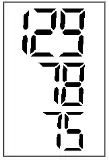
5.5. Memory – displaying the last measurement
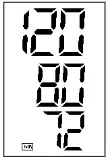
The last measured result is stored in the instrument until a new measurement is carried out or the batteries are empty or removed. You can call up the stored value at any time by pressing the O/I MEMORY button for at least 3 seconds.
5.6. Discontinuing a measurement
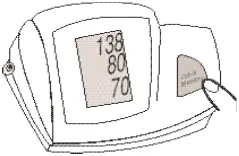
If it is necessary to interrupt a blood pressure measurement for any reason (e.g the patient feels unwell), the O/I MEMORY button can be pressed at any time. The device then immediately lowers the cuff-pressure automatically.
6. Error messages/malfunctions
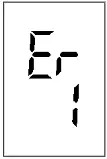
If an error occurs during a measurement, the measurement is discontinued and a corresponding error code is displayed.(Example Error no. 1)
Error No. Possible cause(s)
ERR 1 The systolic pressure was determined but afterwards the cuff pressure fell below 20mm Hg. This situation can occur, for example, if the tube becomes unplugged after the systolic blood pressure has been measured. Further possible cause: No pulse has been detected.
ERR 2 Unnatural pressure impulses influence the measurement result. Reason: The arm was moved during the measurement (Artefact).
9
IB BP 3BXO-A 3804_4 16/9/04 13:24 Page 10
ERR 3 Inflation of the cuff takes too long. The cuff is not correctly seated or the hose connection is not sealed
ERR 5 The measured results have indicated an unacceptable difference between the systolic and diastolic pressure. Take another measurement, carefully following the instructions. Contact your doctor, if you still obtain unusual results.
LO Below 40 pulses per min.
HI 200 or more pulses per min.
Other possible malfunctions and their eliminations
If problems occur when using the device, the following points should be checked and if necessary, the corresponding measures are to be taken:
Malfunction Remedy
The display remains empty when the instrument is switched on although the batteries are in place.
- Check whether the batteries are installed with the correct polarity and correct if necessary.
- If the display is unusual, remove the batteries and then exchange them for new.
The pressure does not rise although the pump is running.
- Check the connection of the cuff tube and connect properly if necessary.
The device frequently fails to measure the blood pressure values, or the values measured are too low (too high).
- Fit the cuff correctly on the arm.
- Before starting the measurement make sure that the cuff is not fitted too tightly and that there is no rolled-up sleeve exerting pressure on the arm above the measuring position. Take off articles of clothing if necessary.
- Measure the blood pressure again in complete peace and quiet.
Every measurement results in different values although the device functions normally and the values displayed.
- Please read the following information and the points listed under «Common sources of error». Repeat the measurement.
The blood pressure values measured differ from those measured by the doctor.
- Record the daily development of the values and consult your doctor about them.
 Further information
Further information
The level of blood-pressure is subject to fluctuations even with healthy people. Important thereby is, that comparable measurements always require the same conditions (Quiet conditions)!
You must consult your specialist dealer or chemist if there are technical problems with the blood-pressure instrument. Never attempt to repair the instrument yourself!
Any unauthorised opening of the instrument invalidates all guarantee claims!
10
7. Care and maintenance, recalibration
a) Do not expose the device to either extreme temperatures,humidity, dust or direct sunlight.
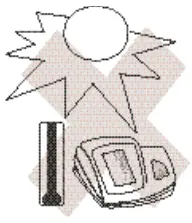
b) The cuff contains a sensitive air-tight bubble. Handle this carefully and avoid all types of straining through twisting or buckling.
c) Clean the device with a soft, dry cloth. Do not use petrol,thinners or similar solvent. Spots on the cuff can be removed carefully with a damp cloth and soapsuds. The cuff must not be washed!
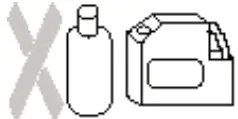
d) Handle the tube carefully. Do not pull on it. Likewise, this is not to be buckled or laid over sharp edges.
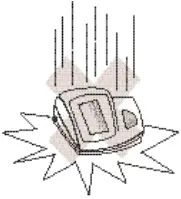
e) Do not drop the instrument or treat it roughly in any way.Avoid strong vibrations.
f) Never open the device! Otherwise the manufacturer calibration becomes invalid!
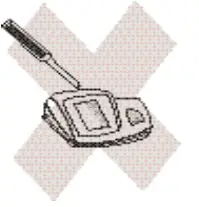
g) Remove the batteries if the device will not be used for along time. Do not use batteries beyond their date of expiry.
Periodical recalibration
Sensitive measuring devices must from time to time be checked for accuracy. We therefore recommend aperiodical inspection of the static pressure display every 2 years.
Your specialist dealer would be pleased to provide more extensive information about this.
8. Guarantee
The ‘as easy as 123’ blood-pressure monitor is guaranteed for 2 years from date of purchase. This guarantee includes the instrument and the cuff. The guarantee does not apply to damage caused by improper handling, accidents, not following the operating instructions or alterations made to the instrument by third parties. Please retain your proof of purchase to confirm the start of your 2 year guarantee period.
11
IB BP 3BXO-A 3804_4 16/9/04 13:24 Page 12
9. Reference to standards
Device standard:
Device corresponds to the requirements of the European standard fornon-invasive blood-pressure monitor
EN1060-1 / 12:95
EN1060-3 / 09:97
EN1060-4
Electromagn. compatibility:Device fulfills the stipulations of the European standard EN 60601-1-2
The stipulations of the EU-Guidelines 93/42/EWG for Medical Products Class IIa have been fulfilled.
10. Technical specifications:
Weight:
465 g (with batteries)
Size:
131 (W) x 174 (L) x 73 (H) mm
Storage temperature:
–5 to +50°C
Humidity:
15 to 85% relative humidity maximum
Operation temperature:
10 to 40°C
Display:
LCD-Display (Liquid Crystal Display)
Measuring method:
oscillometric
Pressure sensor:
capacitive
Measuring range:
SYS/DIA: 30 to 280 mmHg
Pulse: 40 to 200 per minute
Cuff pressure display range:
0–299 mmHg
Memory:
Storing the last measurment automatically
Measuring resolution:
1 mmHg
Accuracy:
Pressure within ± 3 mmHg
Pulse ± 5 % of the reading
Power source:
a) 4 dry cells (batteries) UM-3, size AA, 1.5 V
b) mains adaptor 6 V DC 600 mA (voltage 4.5 V DC to 6 V DC)
Accessories:
cuff type M for arm circumference 22– 32 cm
cuff type L for arm circumference 32– 42 cm
Technical alterations reserved!
11. Contact details:
Microlife UK, Number 8 The Green,
St. Leonards-on-Sea, East Sussex TN38 0SY,
Tel: + 44 (0) 1424 43 43 00 Fax: + 44 (0) 1424 43 43 11
Email: [email protected] Web: www.microlife.uk.com
